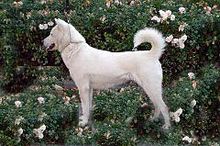Kishu Inu
 |
||||||||||||||||||
| Other names | Kishu-Ken Kishu-Inu |
|||||||||||||||||
|---|---|---|---|---|---|---|---|---|---|---|---|---|---|---|---|---|---|---|
| Origin | Japan | |||||||||||||||||
|
||||||||||||||||||
|
||||||||||||||||||
| Notes | Also JKC and NIPPO recognized - AKC, FCI, and UKC information in the cut. | |||||||||||||||||
| Domestic dog (Canis lupus familiaris) | ||||||||||||||||||
| Traits | |||
|---|---|---|---|
| Weight | 30–60 lb (14–27 kg) | ||
| Height | 17–22 in (43–56 cm) | ||
| Colour | black (black & tan), brindle, red, sesame, pinto, white (most prevalent) | ||
| Classification / standards | |||
|---|---|---|---|
| FCI | Group 5, Section 5 Asian Spitz and related breeds #318 | standard | |
| AKC | |||
| The AKC Foundation Stock Service (FSS) is an optional recording service for purebred dogs that are not yet eligible for AKC registration. | |||
| UKC | Northern Breed | standard | |
The Kishu (紀州犬 Kishū-Inu), sometimes called Kishu Ken or Kishu Inu, is a Japanese breed of dog, developed there for thousands of years. It is descended from ancient medium-sized breeds and named after the Kishu region, now Mie Prefecture and Wakayama Prefecture. This breed is similar to the Hokkaido, Shikoku and the Kai Ken. Sometimes it is mistaken for the white variant of Hokkaido because of very similar appearance. The Japanese originally used this breed of dog for boar and deer hunting. Like the Shiba, they are often quiet. Kishu will stalk prey quietly rather than bark.
The Kishu stands 17-22 inches (43–55 cm) tall, averages 30–60 pounds and is considered a medium-sized dog. The standard only permits solid colored dogs to be shown. Accepted show colors are white, red, or sesame. Although no color is officially preferred, white has become most common in recent decades. The nose color is primarily black, but with the white coat the nose can be brownish or pink in color. The bite is either scissor or a level bite. The tail is either carried in a sickle or curled over the back like that of an Akita or Shiba Inu. The coat is short, straight, and coarse with a thick undercoat. There is fringe on the cheeks and tail. The ears incline forward and are smaller rather than larger. This breed is tough, agile, and friendly.
Kishu Kens are a one person/one family dog. They are courageous and brave as hunters, and will be loyal to their owners. They have a strong prey drive, and will hunt small animals. A few have been known to do well with cats if raised with them. They do well with other dogs if socialized well as puppies, however, due to their pack instincts they might cause some fights for dominance. They are quite headstrong and willful, making training necessary, but they are devoted and loyal to family, getting along well with children, if raised with them. Kishu Kens like to keep an eye on whatever is going on, and sometimes find a high place to look out from. They can be aloof or shy around strangers. They are easily housebroken, intelligent, and strong willed.
Health problems with the Kishu Ken are occasional hypothyroidism (low thyroid), which is not uncommon among the Japanese breeds, and affects perhaps one in ten dogs. It is not life-threatening and treatment is a thyroid pill daily for the optimum health of the dog, as with humans. Food and environmental allergies are not uncommon in the Kishu Ken.
...
Wikipedia
